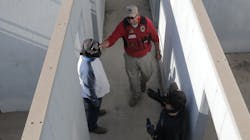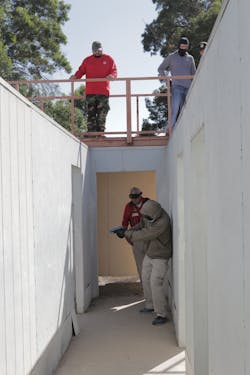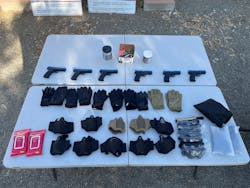BEAST (Building Entry and Search Techniques) Training
I have some good friends in the firearms industry. Some of them forget that I have a poor memory for events. This was clearly evident when my friend Gene Whisenand of Trident Firearms Academy invited me to one of his classes six months prior to the training event. He sent me a bunch of photos of an Umarex T4E Smith & Wesson M&P9 and asked me if I wanted to play with them. I replied “yes” and put “Meet Gene at range and bring a sweatshirt or a jacket” on my phone. I forgot all about it and even though we chat all the time, the subject never came up again.
I showed up at the range. Trident Firearms Academy uses the Livingston Police Department Range, in California’s Central Valley. Local agencies train there because they have a shoot house, a pistol combat range, and an abbreviated lane for shooting 100-plus yards. Many agencies rely on the Livingston Police Department for its unique training facility.
As I was getting out of my pickup, another participant walked up to me and asked if I was ready for my day. I said, “I dunno. Gene just told me to show up today wearing a sweatshirt, and I did.” He gave me a puzzled look and backed away.
This was my introduction to the Trident Firearms Academy’s 8-hour BEAST (Building Entry and Search Techniques) class. Trident Firearms Academy uses Umarex T4E markers, which fire .43 caliber paintballs, for realistic training, without training scars.Retired Sgt. Dan Gray gave us the classroom instruction. He walked us through the concepts of slicing the pie, quick peek and dynamic entries.
Dan was my shift sergeant back in the day. I am very familiar with his abilities when it comes to building searches. We searched for many suspects together, taught and trained together for years. Gene and I shoot together often, and his military and civilian experience with firearms is respectable. Together, Trident Firearms covered the basics of movement and searching.
The focus of the instruction was for civilian CCW and armed citizens, but the training was appropriate for anyone who operates on the friendly side of the muzzle. The training requires appropriate attire: jackets or sweatshirts, full face protection and gloves.
Livingston Police Department hosts one of the best “shoot houses,” non-live fire training facilities, in the region. It consists of a square facility made up of random rooms and hallways, perfectly capable of containing training projectiles. There is no roof. There is a 360 degree catwalk built around the perimeter of the structure. There are rooms with closets, and rooms as small as closets, as well as rooms like regular living rooms. Instructors can add furniture and obstacles.
Training occurs whether the student is in the scenario, or observing from the catwalk. From the catwalk, students can quickly critique their own strategies in real time, as they observe other students in scenarios.
Umarex USA Products makes several products appropriate for this training. We used the GLOCK 17 Gen5 T4E, and the T4E Smith & Wesson M&P9 M2.0. Both models look, feel, and operate like their real counterparts. They use 12-gram CO2 cartridges, which are housed in the magazine assembly. The juncture between the gun and magazines has a separate seal. When the magazine is removed, the gun is inert and the magazine remains charged, allowing “hot” magazine swaps, and fire continuity.
Not only do the magazines feel and load like the primer fired ones, the weight is similar to loaded ones also. The magazines hold 8 rounds. I don’t remember how many rounds could be fired from a full CO2 cylinder, but we didn’t change the first couple until we were several hours into scenarios and many of us were sporting a few powder blooms.
Umarex USA offers 3 different types of projectiles: Paint, powder, and rubber pellets. The paint and powder do basically the same thing, but the powder mark is slightly less persistent. Gene opted for powder, even though it is a little more expensive to run.
I have used the T4E products before, and they are amazing. They fit the same holsters, accessories, and attachments, and their “feel” is remarkably similar to the real thing. I am both a Glock and a S&W user, and the utility of these tools go far beyond force on force. They are accurate enough for regular shooter training at close distances, and there are plenty of appropriate drills for them.
These guns took a moderate amount of abuse, and there were no catastrophic failures. They have the sturdiness of real guns, and were designed to last. If I had one recommendation, it would be to offer an optic ready slide for the S&W and Glock models, so agencies have the option to configure them exactly like their duty guns.
I understand that one of the intentions of this design was for paintball users to have a backup handgun-sized marker. I think using them as real training tools is a far better application.I’m not going to lie to you. I was tagged a few times as an interactor, and it hurt. I suppose it would have been different had I been using something with a little more integrity than a windbreaker, but I don’t like being hot. We did use ballistic goggles and throat/neck protectors. The pellets are .43 caliber. For those who play paintball, the standard projectile is .68 caliber. The greater amount of frontal area of the larger paintball dissipates the impact. Therefore, the .43 caliber balls are much better at getting one’s attention.
Mistakes SHOULD be painful in training, and the marks go away after a few days. I do recommend good padded coverage for agencies, which will avoid paperwork.
Dan Gray gave us several different scenarios like a warehouse alarm response, and an intruder about to enter our kid’s bedroom. We did individual and team searches. The rules of engagement for these scenarios. With legalities and liabilities explained, students were to successfully negotiate the scenarios.
Lessons learned
In my first scenario, I played the bad guy for my training partner. When he stepped into my piece of real estate, I lit him up. Unfortunately, I train to shoot until the threat is no longer a threat. By the time our safety officer called “endex,” my new friend David had a half dozen hits on an area only covered by a t-shirt. I was like, “Gee Dan, no one said there was a round limit.” Sorry David. He wore the welts proudly for the rest of the day. He was also the person who tagged me between my eyes later that day. The lesson here: Paybacks are part of training.
Once observers are in place, they should be discouraged from moving around, or conversing. What I noticed right away was the phenomenon of congregating behind the “bad guy” in order to see the action. All the Officer has to do is look up and they can guess in which room the threat resides.
Stoppages are training opportunities. These markers proved to be highly reliable, but there were stoppages. The projectiles were designed to break on impact, and sometimes they broke prematurely, clogging the works. The Umarex USA T4E products we used cleared in the same manner the real things cleared, mostly. That is, users can TAP, RACK, TARGET, for another shot.
Since most of the stoppages and clearing appeared to happen in the magazine, and not in the gun, I have a recommendation for agency trainers: Issue the magazines to end users, and make them responsible for all aspects of magazine maintenance during training. In this manner, they can keep the magazine stoked with gas and projectiles. The user can keep the same couple of magazines throughout the day. This was not my idea, by the way. One of the students suggested it, but I did not get his name.
As a police officer, our agency used the Livingston Police Department facility regularly. Several instructional styles can be supported by this type of facility. It doesn’t matter if the walls are immovable. The suspects/scenarios/furniture can be moved around enough to get a career’s worth of training from this place.
This type of facility can be built as a co-op project for the local agencies or as a gift from the community for local agencies. If your agency does not have a shoot house, find a way to build one.
Three things that should always exist in this type of training:
- Safety
- Safety
- Safety
Do AARs (After Action Reports) often. This type of training should be peppered with informal AARs throughout the training. For example, while playing the “bad guy,” I exposed myself briefly to the searching team, then disappeared behind the wall. I decided to “pop out” quickly the second time. This time I crouched low before moving. I took a hit right between the eyes. The shooter went from a low ready to a headshot quickly. I watched him do it. He did it quicker than I could jump back behind cover. Everyone saw this. I will remember that if I ever expose myself to a threat. If the threat potentially had a center mass shot the first time, I just gave them an incapacitating target.
Always, always, have a “no-shoot” scenario. This will reinforce the importance of having firearms handling skills, decision making skills, and get students out of “search and destroy” mode.
There are things about searching or clearing a building that definitely improve with practice. I teach this skill regularly, and it is actually not hard to monitor improvement. Firearms trainers can tell you that a (hazardous and sometimes fatal) error of building searches is the Officer exposing a target long before they are able to engage. For example, it is correct to lead with the muzzle, but if the muzzle pokes around a corner before the user can engage, it is problematic. Experienced Officers know when to employ a compressed ready position to keep body parts behind cover. This comes with practice, and experts are produced by being behind a gun, not a computer screen.
Whomever maintains this type of facility for your training, take care of them. Provide training opportunities for them, buy the sergeant who manages the facility a cup of coffee, mow the lawn and keep it painted. The investment my agency made in this kind of training literally kept me out of trouble.
About the Author

Officer Lindsey Bertomen (ret.), Contributing Editor
Lindsey Bertomen is a retired police officer and retired military small arms trainer. He teaches criminal justice at Hartnell College in Salinas, California, where serves as a POST administrator and firearms instructor. He also teaches civilian firearms classes, enjoys fly fishing, martial arts, and mountain biking. His articles have appeared in print and online for over two decades.


